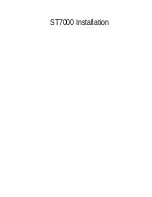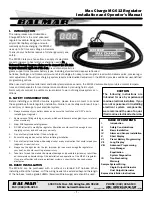
Lake Shore Model 370 AC Resistance Bridge User’s Manual
4.5.1
Voltage Excitation Mode
In voltage excitation mode the excitation selection in volts is treated as a not to exceed value. The instrument assigns an
excitation current to each resistance range that keeps the measurement voltage is as large as possible without exceeding
the selected excitation voltage. Current is changed to accommodate resistance range or voltage excitation parameter
changes.
To use voltage excitation mode press the
Voltage Mode
key. The LED annunciator above that key will light to indicate
the excitation mode. The excitation display line in the lower right corner of the display will also change to indicate the
maximum excitation in volts. Current excitation arrow keys are locked out.
To change the voltage excitation use the
Voltage Excitation
VW
keys. Available ranges are listed in Table 1-1. As the
table indicates, not every combination of voltage excitation and resistance range is possible. The following messages are
displayed in the excitation display to indicate limits.
Maximum
Maximum voltage excitation has already been chosen
Minimum
Minimum voltage excitation has already been chosen
Increase Resistance
Resistance range must be increased before changing voltage excitation
Decrease Resistance
Resistance range must be decreased before changing voltage excitation
Resistance ranges have approximately 20% over range but it is recommended that the range be increased when the
reading is at full scale for the range to guarantee enough overhead to account for noise voltages. Better measurement
resolution can be achieved by decreasing the resistance range when the reading is below 20% of full scale.
To change the resistance range
Resistance Range
VW
keys. Available ranges are listed in Table 1-1. The following
messages are displayed to indicate range limits.
Maximum
Maximum resistance range has already been chosen
Minimum
Minimum resistance range has already been chosen
Increase Excitation
Voltage excitation must be increased before changing resistance range
Decrease Excitation
Voltage excitation must be decreased before changing resistance range
The autorange feature allows the instrument to automatically choose an appropriate resistance range. The instrument will
increase the resistance range (decrease excitation current) if the measurement reaches full scale. Normally no over range
error is created because of the approximate 20% over range capability of the input. Over range errors are possible when
resistance changes very quickly or when resistance increases beyond the limit of the voltage excitation selection. The
autorange algorithm will not change the excitation setting to accommodate larger resistances. The instrument will
decrease the resistance range (increase excitation current) if the measurement drops below 20% of full scale. Autorange
is not recommended when resistance changes are very fast, measurements are very noisy or when data acquisition cannot
tolerate a range change delay in the middle of a data set.
To turn autorange on or off press the
Autorange
key. The LED annunciator above the key lights to indicate autorange is
on.
4.5.2
Current Excitation Mode
In current excitation mode one of the instrument current source selections is chosen directly as excitation. Gain of the
measurement input is changed to accommodate different resistance ranges.
To use current excitation mode press the
Current Mode
key. The LED annunciator above that key will light to indicate
the excitation mode. The excitation display line in the lower right corner of the display will also change to indicate the
current excitation in amps. Voltage excitation arrow keys are locked out.
Operation
4-7
Содержание 370
Страница 22: ...Lake Shore Model 370 AC Resistance Bridge User s Manual 1 12 Introduction This Page Intentionally Left Blank ...
Страница 60: ...Lake Shore Model 370 AC Resistance Bridge User s Manual 3 16 Installation This Page Intentionally Left Blank ...
Страница 106: ...Lake Shore Model 370 AC Resistance Bridge User s Manual 5 12 Advanced Operation This Page Intentionally Left Blank ...
















































